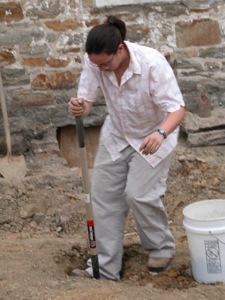Pacific Ave. Update
 I spent some time this week - along with volunteer, fellow grad student and Medfield resident Jenn Babiarz - excavating shovel test pits (stp's) at the house on Pacific Avenue. "What," you may ask, "are shovel test pits?" They are 18" round excavations, dug on a grid, that are designed to detect the presence or absence of archaeological sites and deposits of artifacts (archaeologists call these deposits "features") in a given area. In this case, we wanted to find out if an area that will be covered by new construction contained any features, such as a filled root cellar, well, or cistern. Features such as these tend to catch lots of artifacts that can provide insight into how people lived in the past.
I spent some time this week - along with volunteer, fellow grad student and Medfield resident Jenn Babiarz - excavating shovel test pits (stp's) at the house on Pacific Avenue. "What," you may ask, "are shovel test pits?" They are 18" round excavations, dug on a grid, that are designed to detect the presence or absence of archaeological sites and deposits of artifacts (archaeologists call these deposits "features") in a given area. In this case, we wanted to find out if an area that will be covered by new construction contained any features, such as a filled root cellar, well, or cistern. Features such as these tend to catch lots of artifacts that can provide insight into how people lived in the past.We knew going in that our chances were fairly slim. The area had already had some earth-moving occur, and asbestos clean-up removed a lot of soil. Nonetheless, I wanted to be reasonably sure that we didn't miss anything. We began by picking a datum point - a reference point on the landscape that isn't likely to move - and measuring a grid from there with long tapes. We then laid in ten excavation areas, each six meters apart in two rows within the impact zone of the new construction. Over the course of several hours, we excavated each of these down into the undisturbed subsoil. We located a number of artifacts, including some marbles, pieces of nineteenth century ceramic, and machine cut nails, but did not find evidence of buried features. We did however, take notice of a large foundation wall in the area that had sustaine
 d some damage from construction equipment.
d some damage from construction equipment.We were glad to learn that the new construction would not hurt any important archaeological resources. Trenching activity in the previous week appears to have cut through an intact feature at the back of the lot, turning up a number of artifacts. We were also intrigued by this large foundation wall and plan to go back on Thursday to excavate within that trench. Hopefully, deposits we find there will give us some insight into the dating and purpose of that wall. Eventually, we hope to do more extensive excavations throughout the yard of this house, that will help us determine the construction date of the building, and more importantly tell us something we don't know about the lives of people who lived in nineteenth-century Hampden.
Update: I've invited Jenn to contribute to this blog. Anybody that comes out to volunteer can have a chance to post as well. Very exciting. Be sure and email if you are interested in joining us for some excavations.

0 Comments:
Post a Comment
<< Home